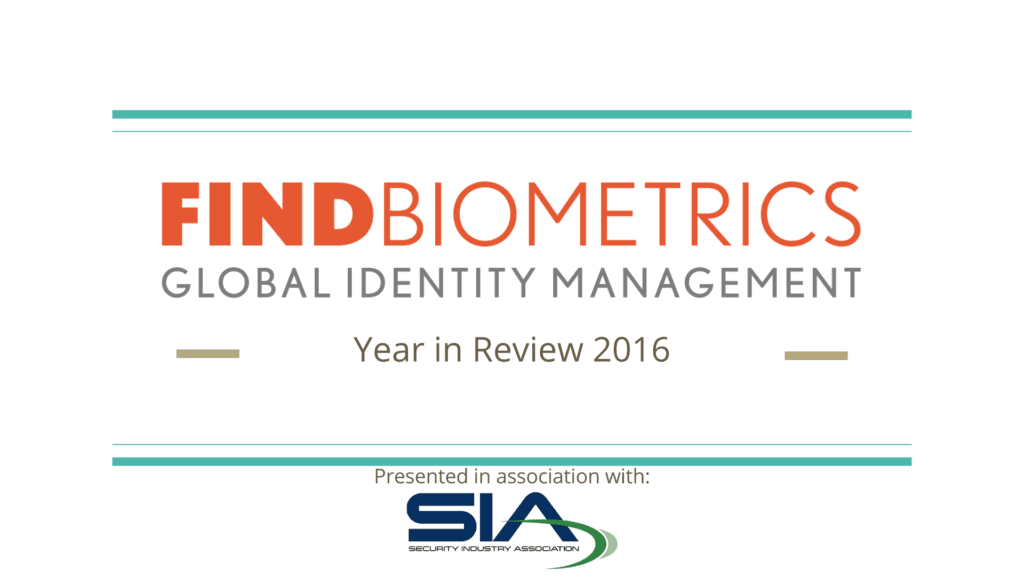In December we polled 165 professionals in biometrics and identity related industries about various topics from the past year. It was part of the FindBiometrics Year in Review, the longest-running and best regarded industry retrospective of its kind. Now in its 14th consecutive year, the FindBiometrics Year in Review is your resource to start 2017 off with your fingers on the pulse of biometrics and global identity management.

As we have been examining the results of our Year in Review survey, the concept of mainstreaming, popularity, and consumer ubiquity have frequently arisen. And it’s appropriate, too: biometric technologies are becoming common thanks to innovations in accessibility that have allowed them to become a part of everyday life—whether they’re being used to unlock a phone, protect a border-crossing, conduct a background check, or are just the topic of a newspaper editorial.
But it’s also no secret that biometrics carry a stigma in the public eye, having long been primarily associated with the world of criminal law enforcement and surveillance. With privacy becoming an increasingly pressing topic in the discourse surrounding connected and mobile technology, and with biometrics rising in popularity faster than the general public can be expected to educate themselves on it, one wonders how important of a role public perception of biometrics plays in the industry. We asked our survey respondents how strongly they agree or disagree with the following statement:
Public perception of biometrics plays an important role in the future of the identity industry.
Here is what they had to say:
It’s nearly unanimous agreement on the front of public perception playing an important role in the future of the identity industry. Last year we saw similarly positive results in this regard, and very little seems to have changed in the attitudes of respondents. Sixty-four percent of all survey respondents strongly agree with the statements, while 34 percent agree a bit less emphatically, and only three percent disagree at all.
With Great Popularity Comes Great Familiarity
 As for the state of public perception of biometrics, the general paradigm seems to be shifting to one of enthusiasm. Along with the growing ubiquity of biometric smartphones comes a familiarity with fingerprint, voice, and facial recognition technology. If iris biometrics becomes the next big consumer modality, (as is expected with the launch of new flagship smartphones), it will also be subject to such familiarization with the public, with mobile wallets and mobile security platforms emphasizing how convenient biometrics can be as authenticators.
As for the state of public perception of biometrics, the general paradigm seems to be shifting to one of enthusiasm. Along with the growing ubiquity of biometric smartphones comes a familiarity with fingerprint, voice, and facial recognition technology. If iris biometrics becomes the next big consumer modality, (as is expected with the launch of new flagship smartphones), it will also be subject to such familiarization with the public, with mobile wallets and mobile security platforms emphasizing how convenient biometrics can be as authenticators.
On a world stage, the perception of biometics also benefited from an increased presence at major technology events throughout 2016. The FindBiometrics team witnessed this first-hand, as company president Peter O’Neill hosted identity tech panels at Mobile World Congress Shanghai, Money20/20 Europe, and Money 20/20 2016 in Las Vegas — the last of which was over-attended to the point where fire marshals had to close the hall. So there is a great amount of enthusiasm for biometrics outside of the industry proper, much of it being stoked by simple familiarity on behalf of consumers and service providers seeing opportunity to improve their offerings with convenient security.
Riding The Controversy
 The aforementioned mainstreaming of biometrics seems to be improving public perception of the technology in general, and that is in turn leading to a more balanced dialogue surrounding matters of identity. In 2016, one of the main stages for the battle over public perception of biometrics was the ongoing battle between ridesharing app companies and public safety advocates. All year conflicts have been rising up as Uber and Lyft have resisted legislation to mandate for fingerprint-based background checks. While the battle is still ongoing, with rideshare companies still holding out, the strife has kept biometric myth-busting in the media spotlight, so much so that at the dawn of the New Year, Washington Post published a pro-biometrics editorial on the subject.
The aforementioned mainstreaming of biometrics seems to be improving public perception of the technology in general, and that is in turn leading to a more balanced dialogue surrounding matters of identity. In 2016, one of the main stages for the battle over public perception of biometrics was the ongoing battle between ridesharing app companies and public safety advocates. All year conflicts have been rising up as Uber and Lyft have resisted legislation to mandate for fingerprint-based background checks. While the battle is still ongoing, with rideshare companies still holding out, the strife has kept biometric myth-busting in the media spotlight, so much so that at the dawn of the New Year, Washington Post published a pro-biometrics editorial on the subject.
Continuing The Conversation
 Of course, while the public perception of biometrics has come a long way since the early days of Apple’s Touch ID, when the idea of unlocking a phone with a fingerprint was scoffed at by many, there is still ground to cover. As we discussed in our previous Year in Review post on liveness detection, the threat of presentation attacks (aka spoofing) is often greatly exaggerated when new methods of covertly capturing someone’s biometric data are discovered. Furthermore, privacy controversy still tend to paint biometrics in a negative light, with 2016 notably being the year when the FBI’s use of facial recognition came under scrutiny for its lack of transparency and proper oversight.
Of course, while the public perception of biometrics has come a long way since the early days of Apple’s Touch ID, when the idea of unlocking a phone with a fingerprint was scoffed at by many, there is still ground to cover. As we discussed in our previous Year in Review post on liveness detection, the threat of presentation attacks (aka spoofing) is often greatly exaggerated when new methods of covertly capturing someone’s biometric data are discovered. Furthermore, privacy controversy still tend to paint biometrics in a negative light, with 2016 notably being the year when the FBI’s use of facial recognition came under scrutiny for its lack of transparency and proper oversight.
That being said, it is difficult to overstate the progress being made in the area of positive public perception in biometrics. Whether it’s as a security measure, a convenience feature, or an integral aspect of public safety — biometrics are in the public conversation of technology, connectivity, and identity, and that conversation is becoming more informed and dynamic every day.
*
Stay posted to FindBiometrics throughout January as we continue to breakdown our Year in Review 2016 results.
The FindBiometrics Year in Review is presented in association with SIA and made possible by our sponsor: Tascent



Follow Us